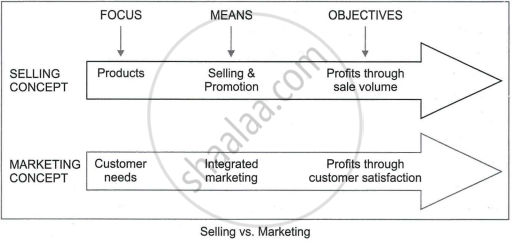Advertisements
Advertisements
Questions
Distinguish between Marketing and Selling.
Distinguish clearly between marketing and sales.
Solution 1
| Basis of Distinction | Marketing | Selling | |
| 1. | Scope | Total system consisting of planning, pricing, promoting and distributing products. | A part of marketing involving persuasion and directing flow of products to customers. |
| 2. | Beginning | Begins much before goods are produced to understand the needs and preferences of consumers. | Begins after the goods are produced. |
| 3. | End | Continues even after sale so as to provide after-sale service and to judge reactions of consumers. | Comes to an end with the delivery of goods to customers. |
| 4. | Orientation | Customer-oriented, the aim being to satisfy the needs of buyers. | Product-oriented, the aim being to satisfy the needs of the seller. |
| 5. | Focus | On long-term growth and profitability of business. | On short-term maximisation of profits. |
| 6. | Means used | Integrated approach. | Persuasion and promotion. |
| 7. | Objective | Profits through customer satisfaction. | Profits through sales volume. |
| 8. | Principle | Caveat vendor - let the seller beware. | Caveat emptor - let the buyer beware. |

Solution 2
| Basis of Distinction | Marketing | Selling |
| 1. Meaning | Identifying and satisfying wants. | Exchanging goods for money. |
| 2. Objective | Ensuring growth and stability of the firm - long-term goals. | Maximising profits through increase in sales volume - Short-term goals. |
| 3. Orientation | Customer-oriented, let the seller beware. | Production-oriented, let the buyer beware. |
| 4. Scope | Wider in scope includes selling. | Narrow in scope part of marketing. |
| 5. Beginning and end | Begins before production and continues after sale. | It begins after production and ends with a sale. |
| 6. Focus | External; on customer's needs. | Internal, on seller's needs. |
| 7. Demand | Involves creation and maintenance of demand. | Presupposes the existence of demand. |
| 8. Growth | New and modern concept. | Old and traditional concepts. |
| 9. Approach | Integrated approach for achieving long-term goals. | Fragmented approach for immediate gain. |
| 10. Process | Converting customer's needs into products and services. | Converting products and services into cash. |
| 11. Nature of activity | Philosophy and attitude. | Routine and tactical. |
APPEARS IN
RELATED QUESTIONS
Caveat vendor means ______.
Marketing concentrates on ______.
Selling pre-supposes the existence of demand for the firm's product; on the other hand, marketing involves creation and maintenance of ______ demand.
Selling involves ______ of goods and services.
Selling is internally oriented because it seeks to ______ profits through increased volume of sale.
______ begins before production and continues even after sale.
Selling is ______ and ______.
Which of the statements are not true for selling?
"Marketing is customer-oriented whereas selling is producer oriented." Explain.
Selling involves exchange of goods for money between the sellers and buyers. Selling focuses on the needs of seller, and the marketing, on the needs of the ______.
Marketing is a ______ term than selling.
The latest method of direct selling is ______.
Selling aims at ______.
